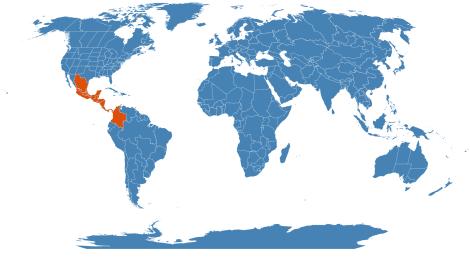Accession Data
Diospyros nigra
Common Name: Black Sapote, Chocolate Pudding Fruit
Family: Ebenaceae
Country of Origin: Mexico to Colombia
Description: A usually large, green-skinned fruit about the size of an apple. Flesh turns dark brown/black when ripe. Pulp both looks and tastes somewhat like chocolate pudding. Black sapote's make a wonderful dessert fruit.
Uses: Eaten fresh or used in desserts. Black sapote mousse's, cakes, custards are popular dishes where black sapote's are grown.
Accession Data
USDA Zone: 10b
Accession #: 199900008
Accession Date: 1999-05-13 00:00:00
Bloom Status: 🪴 Not Flowering
Location: 1309
Quantity: 1
Source: John Maugeri
Culture: Large tree to 80ft. Full grown trees can survive to 28F. Trees are not too particular about soil and nutrient support. Fruits ripen in winter but depending on the tree may fruit a few months earlier or later. Fruits are best picked and eaten when fully ripe, the pulp becomes soft and pudding like at this stage.
Propagation: Usually grown from seeds which make it to bearing age in 5-6 years.
Classification
Division: Magnoliophyta
Class: Magnoliopsida
Subclass: asterids
Order: Ericales
Family: Ebenaceae
Flowering Data:
This accession has been observed in bloom on:| Year | Jan | Feb | Mar | Apr | May | Jun | Jul | Aug | Sep | Oct | Nov | Dec | ||||||||||||||||||||||||||||||||||||||||
|---|---|---|---|---|---|---|---|---|---|---|---|---|---|---|---|---|---|---|---|---|---|---|---|---|---|---|---|---|---|---|---|---|---|---|---|---|---|---|---|---|---|---|---|---|---|---|---|---|---|---|---|---|
| 2025 | ||||||||||||||||||||||||||||||||||||||||||||||||||||
| 2024 | ||||||||||||||||||||||||||||||||||||||||||||||||||||
| 2023 | ||||||||||||||||||||||||||||||||||||||||||||||||||||
| 2022 | ||||||||||||||||||||||||||||||||||||||||||||||||||||
| 2021 | ||||||||||||||||||||||||||||||||||||||||||||||||||||
| 2020 | ||||||||||||||||||||||||||||||||||||||||||||||||||||
| 2019 | ||||||||||||||||||||||||||||||||||||||||||||||||||||
| 2018 | ||||||||||||||||||||||||||||||||||||||||||||||||||||
| 2017 | ||||||||||||||||||||||||||||||||||||||||||||||||||||
| 2016 | ||||||||||||||||||||||||||||||||||||||||||||||||||||
| 2015 | ||||||||||||||||||||||||||||||||||||||||||||||||||||
| 2014 | ||||||||||||||||||||||||||||||||||||||||||||||||||||
| 2013 | ||||||||||||||||||||||||||||||||||||||||||||||||||||
| 2012 | ||||||||||||||||||||||||||||||||||||||||||||||||||||
| 2011 | ||||||||||||||||||||||||||||||||||||||||||||||||||||
| 2010 | ||||||||||||||||||||||||||||||||||||||||||||||||||||
| 2009 | ||||||||||||||||||||||||||||||||||||||||||||||||||||
References
-
Fruit Database - Tradewinds Fruit - site visited 9/13/01
- The Plant List (2013). Version 1.1. Last accessed on Wednesday, January 04, 2017.
- WCSP (2016). World Checklist of Selected Plant Families. Facilitated by the Royal Botanic Gardens, Kew. Last accessed on Wednesday, January 04, 2017.
- Morton, J. 1987. Black Sapote. p. 416–418. In: Fruits of warm climates. Julia F. Morton, Miami, FL.
Images

